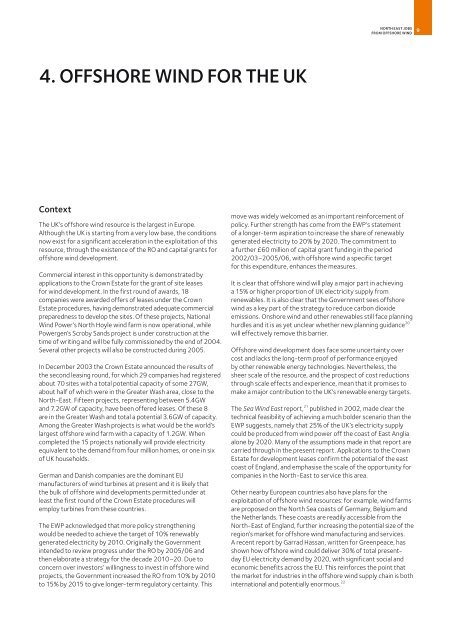offshore wind onshore jobs - a new industry for ... - Greenpeace UK
offshore wind onshore jobs - a new industry for ... - Greenpeace UK
offshore wind onshore jobs - a new industry for ... - Greenpeace UK
You also want an ePaper? Increase the reach of your titles
YUMPU automatically turns print PDFs into web optimized ePapers that Google loves.
NORTH EAST JOBS<br />
FROM OFFSHORE WIND<br />
9<br />
4. OFFSHORE WIND FOR THE <strong>UK</strong><br />
Context<br />
The <strong>UK</strong>’s <strong>offshore</strong> <strong>wind</strong> resource is the largest in Europe.<br />
Although the <strong>UK</strong> is starting from a very low base, the conditions<br />
now exist <strong>for</strong> a significant acceleration in the exploitation of this<br />
resource, through the existence of the RO and capital grants <strong>for</strong><br />
<strong>offshore</strong> <strong>wind</strong> development.<br />
Commercial interest in this opportunity is demonstrated by<br />
applications to the Crown Estate <strong>for</strong> the grant of site leases<br />
<strong>for</strong> <strong>wind</strong> development. In the first round of awards, 18<br />
companies were awarded offers of leases under the Crown<br />
Estate procedures, having demonstrated adequate commercial<br />
preparedness to develop the sites. Of these projects, National<br />
Wind Power’s North Hoyle <strong>wind</strong> farm is now operational, while<br />
Powergen’s Scroby Sands project is under construction at the<br />
time of writing and will be fully commissioned by the end of 2004.<br />
Several other projects will also be constructed during 2005.<br />
In December 2003 the Crown Estate announced the results of<br />
the second leasing round, <strong>for</strong> which 29 companies had registered<br />
about 70 sites with a total potential capacity of some 27GW,<br />
about half of which were in the Greater Wash area, close to the<br />
North-East. Fifteen projects, representing between 5.4GW<br />
and 7.2GW of capacity, have been offered leases. Of these 8<br />
are in the Greater Wash and total a potential 3.6GW of capacity.<br />
Among the Greater Wash projects is what would be the world’s<br />
largest <strong>offshore</strong> <strong>wind</strong> farm with a capacity of 1.2GW. When<br />
completed the 15 projects nationally will provide electricity<br />
equivalent to the demand from four million homes, or one in six<br />
of <strong>UK</strong> households.<br />
German and Danish companies are the dominant EU<br />
manufacturers of <strong>wind</strong> turbines at present and it is likely that<br />
the bulk of <strong>offshore</strong> <strong>wind</strong> developments permitted under at<br />
least the first round of the Crown Estate procedures will<br />
employ turbines from these countries.<br />
The EWP acknowledged that more policy strengthening<br />
would be needed to achieve the target of 10% re<strong>new</strong>ably<br />
generated electricity by 2010. Originally the Government<br />
intended to review progress under the RO by 2005/06 and<br />
then elaborate a strategy <strong>for</strong> the decade 2010–20. Due to<br />
concern over investors’ willingness to invest in <strong>offshore</strong> <strong>wind</strong><br />
projects, the Government increased the RO from 10% by 2010<br />
to 15% by 2015 to give longer-term regulatory certainty. This<br />
move was widely welcomed as an important rein<strong>for</strong>cement of<br />
policy. Further strength has come from the EWP’s statement<br />
of a longer-term aspiration to increase the share of re<strong>new</strong>ably<br />
generated electricity to 20% by 2020. The commitment to<br />
a further £60 million of capital grant funding in the period<br />
2002/03–2005/06, with <strong>offshore</strong> <strong>wind</strong> a specific target<br />
<strong>for</strong> this expenditure, enhances the measures.<br />
It is clear that <strong>offshore</strong> <strong>wind</strong> will play a major part in achieving<br />
a 15% or higher proportion of <strong>UK</strong> electricity supply from<br />
re<strong>new</strong>ables. It is also clear that the Government sees <strong>offshore</strong><br />
<strong>wind</strong> as a key part of the strategy to reduce carbon dioxide<br />
emissions. Onshore <strong>wind</strong> and other re<strong>new</strong>ables still face planning<br />
hurdles and it is as yet unclear whether <strong>new</strong> planning guidance 20<br />
will effectively remove this barrier.<br />
Offshore <strong>wind</strong> development does face some uncertainty over<br />
cost and lacks the long-term proof of per<strong>for</strong>mance enjoyed<br />
by other re<strong>new</strong>able energy technologies. Nevertheless, the<br />
sheer scale of the resource, and the prospect of cost reductions<br />
through scale effects and experience, mean that it promises to<br />
make a major contribution to the <strong>UK</strong>’s re<strong>new</strong>able energy targets.<br />
The Sea Wind East report, 21 published in 2002, made clear the<br />
technical feasibility of achieving a much bolder scenario than the<br />
EWP suggests, namely that 25% of the <strong>UK</strong>’s electricity supply<br />
could be produced from <strong>wind</strong> power off the coast of East Anglia<br />
alone by 2020. Many of the assumptions made in that report are<br />
carried through in the present report. Applications to the Crown<br />
Estate <strong>for</strong> development leases confirm the potential of the east<br />
coast of England, and emphasise the scale of the opportunity <strong>for</strong><br />
companies in the North-East to service this area.<br />
Other nearby European countries also have plans <strong>for</strong> the<br />
exploitation of <strong>offshore</strong> <strong>wind</strong> resources: <strong>for</strong> example, <strong>wind</strong> farms<br />
are proposed on the North Sea coasts of Germany, Belgium and<br />
the Netherlands. These coasts are readily accessible from the<br />
North-East of England, further increasing the potential size of the<br />
region’s market <strong>for</strong> <strong>offshore</strong> <strong>wind</strong> manufacturing and services.<br />
A recent report by Garrad Hassan, written <strong>for</strong> <strong>Greenpeace</strong>, has<br />
shown how <strong>offshore</strong> <strong>wind</strong> could deliver 30% of total presentday<br />
EU electricity demand by 2020, with significant social and<br />
economic benefits across the EU. This rein<strong>for</strong>ces the point that<br />
the market <strong>for</strong> industries in the <strong>offshore</strong> <strong>wind</strong> supply chain is both<br />
international and potentially enormous. 22




![[2007] EWHC 311 - Greenpeace UK](https://img.yumpu.com/22079793/1/184x260/2007-ewhc-311-greenpeace-uk.jpg?quality=85)











